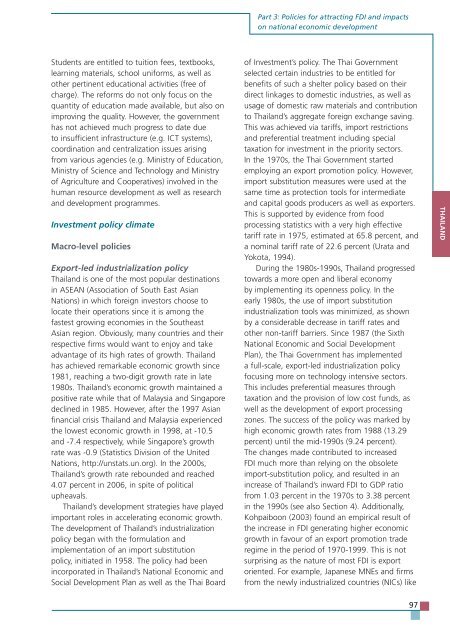TRENDS AND IMPACTS OF FOREIGN INVESTMENT IN DEVELOPING COUNTRY AGRICULTURE
TRENDS AND IMPACTS OF FOREIGN INVESTMENT IN DEVELOPING COUNTRY AGRICULTURE
TRENDS AND IMPACTS OF FOREIGN INVESTMENT IN DEVELOPING COUNTRY AGRICULTURE
You also want an ePaper? Increase the reach of your titles
YUMPU automatically turns print PDFs into web optimized ePapers that Google loves.
Students are entitled to tuition fees, textbooks,<br />
learning materials, school uniforms, as well as<br />
other pertinent educational activities (free of<br />
charge). The reforms do not only focus on the<br />
quantity of education made available, but also on<br />
improving the quality. However, the government<br />
has not achieved much progress to date due<br />
to insufficient infrastructure (e.g. ICT systems),<br />
coordination and centralization issues arising<br />
from various agencies (e.g. Ministry of Education,<br />
Ministry of Science and Technology and Ministry<br />
of Agriculture and Cooperatives) involved in the<br />
human resource development as well as research<br />
and development programmes.<br />
Investment policy climate<br />
Macro-level policies<br />
Export-led industrialization policy<br />
Thailand is one of the most popular destinations<br />
in ASEAN (Association of South East Asian<br />
Nations) in which foreign investors choose to<br />
locate their operations since it is among the<br />
fastest growing economies in the Southeast<br />
Asian region. Obviously, many countries and their<br />
respective firms would want to enjoy and take<br />
advantage of its high rates of growth. Thailand<br />
has achieved remarkable economic growth since<br />
1981, reaching a two-digit growth rate in late<br />
1980s. Thailand’s economic growth maintained a<br />
positive rate while that of Malaysia and Singapore<br />
declined in 1985. However, after the 1997 Asian<br />
financial crisis Thailand and Malaysia experienced<br />
the lowest economic growth in 1998, at -10.5<br />
and -7.4 respectively, while Singapore’s growth<br />
rate was -0.9 (Statistics Division of the United<br />
Nations, http://unstats.un.org). In the 2000s,<br />
Thailand’s growth rate rebounded and reached<br />
4.07 percent in 2006, in spite of political<br />
upheavals.<br />
Thailand’s development strategies have played<br />
important roles in accelerating economic growth.<br />
The development of Thailand’s industrialization<br />
policy began with the formulation and<br />
implementation of an import substitution<br />
policy, initiated in 1958. The policy had been<br />
incorporated in Thailand’s National Economic and<br />
Social Development Plan as well as the Thai Board<br />
Part 3: Policies for attracting FDI and impacts<br />
on national economic development<br />
of Investment’s policy. The Thai Government<br />
selected certain industries to be entitled for<br />
benefits of such a shelter policy based on their<br />
direct linkages to domestic industries, as well as<br />
usage of domestic raw materials and contribution<br />
to Thailand’s aggregate foreign exchange saving.<br />
This was achieved via tariffs, import restrictions<br />
and preferential treatment including special<br />
taxation for investment in the priority sectors.<br />
In the 1970s, the Thai Government started<br />
employing an export promotion policy. However,<br />
import substitution measures were used at the<br />
same time as protection tools for intermediate<br />
and capital goods producers as well as exporters.<br />
This is supported by evidence from food<br />
processing statistics with a very high effective<br />
tariff rate in 1975, estimated at 65.8 percent, and<br />
a nominal tariff rate of 22.6 percent (Urata and<br />
Yokota, 1994).<br />
During the 1980s-1990s, Thailand progressed<br />
towards a more open and liberal economy<br />
by implementing its openness policy. In the<br />
early 1980s, the use of import substitution<br />
industrialization tools was minimized, as shown<br />
by a considerable decrease in tariff rates and<br />
other non-tariff barriers. Since 1987 (the Sixth<br />
National Economic and Social Development<br />
Plan), the Thai Government has implemented<br />
a full-scale, export-led industrialization policy<br />
focusing more on technology intensive sectors.<br />
This includes preferential measures through<br />
taxation and the provision of low cost funds, as<br />
well as the development of export processing<br />
zones. The success of the policy was marked by<br />
high economic growth rates from 1988 (13.29<br />
percent) until the mid-1990s (9.24 percent).<br />
The changes made contributed to increased<br />
FDI much more than relying on the obsolete<br />
import-substitution policy, and resulted in an<br />
increase of Thailand’s inward FDI to GDP ratio<br />
from 1.03 percent in the 1970s to 3.38 percent<br />
in the 1990s (see also Section 4). Additionally,<br />
Kohpaiboon (2003) found an empirical result of<br />
the increase in FDI generating higher economic<br />
growth in favour of an export promotion trade<br />
regime in the period of 1970-1999. This is not<br />
surprising as the nature of most FDI is export<br />
oriented. For example, Japanese MNEs and firms<br />
from the newly industrialized countries (NICs) like<br />
97<br />
THAIL<strong>AND</strong>


